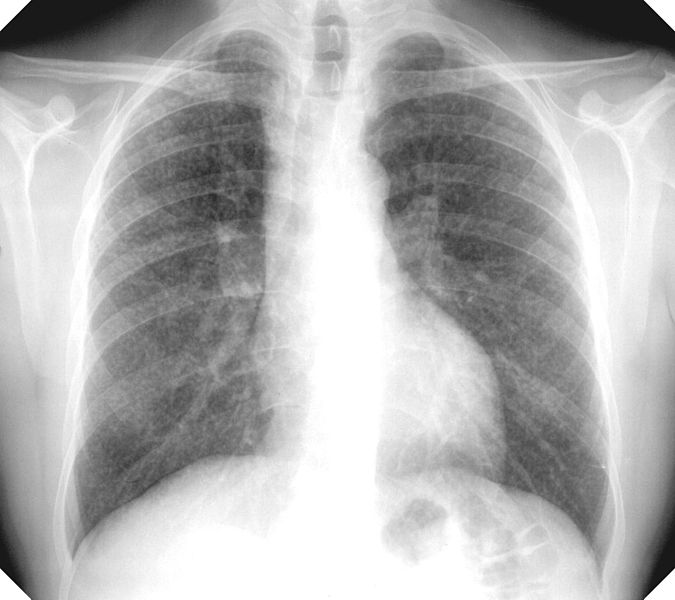Silicosis chest x ray: Difference between revisions
Jump to navigation
Jump to search
Esther Lee (talk | contribs) |
mNo edit summary |
||
| (23 intermediate revisions by 2 users not shown) | |||
| Line 1: | Line 1: | ||
__NOTOC__ | __NOTOC__ | ||
{{Silicosis}} | {{Silicosis}} | ||
{{CMG}} | {{CMG}} {{AE}} {{AV}} | ||
==Overview== | ==Overview== | ||
*A [[chest radiograph]] is obtained in virtually all patients undergoing evaluation for silicosis. It will confirm the presence of [[nodules]] in the lungs, especially in the upper lobes. | |||
==Chest X Ray== | ==Chest X Ray== | ||
*In acute silicosis, the [[chest radiograph]] demonstrates characteristic | |||
:*Bilateral consolidation, | |||
:*Typically symmetrical | |||
:*Diffuse [[ground glass opacities]] which may be perihilar or basilar <ref name="pmid9805764">{{cite journal| author=Duchange L, Brichet A, Lamblin C, Tillie I, Tonnel AB, Wallaert B| title=[Acute silicosis. Clinical, radiologic, functional, and cytologic characteristics of the broncho-alveolar fluids. Observations of 6 cases]. | journal=Rev Mal Respir | year= 1998 | volume= 15 | issue= 4 | pages= 527-34 | pmid=9805764 | doi= | pmc= | url=http://www.ncbi.nlm.nih.gov/entrez/eutils/elink.fcgi?dbfrom=pubmed&tool=sumsearch.org/cite&retmode=ref&cmd=prlinks&id=9805764 }} </ref><ref name="pmid622482">{{cite journal| author=Dee P, Suratt P, Winn W| title=The radiographic findings in acute silicosis. | journal=Radiology | year= 1978 | volume= 126 | issue= 2 | pages= 359-63 | pmid=622482 | doi=10.1148/126.2.359 | pmc= | url=http://www.ncbi.nlm.nih.gov/entrez/eutils/elink.fcgi?dbfrom=pubmed&tool=sumsearch.org/cite&retmode=ref&cmd=prlinks&id=622482 }} </ref>. | |||
*These features may progress from a pattern of lower zone opacities to large masses of coalesced parenchymal tissue in the mid and lower zones, which are typically bilateral but not always symmetrical <ref name="pmid9805764">{{cite journal| author=Duchange L, Brichet A, Lamblin C, Tillie I, Tonnel AB, Wallaert B| title=[Acute silicosis. Clinical, radiologic, functional, and cytologic characteristics of the broncho-alveolar fluids. Observations of 6 cases]. | journal=Rev Mal Respir | year= 1998 | volume= 15 | issue= 4 | pages= 527-34 | pmid=9805764 | doi= | pmc= | url=http://www.ncbi.nlm.nih.gov/entrez/eutils/elink.fcgi?dbfrom=pubmed&tool=sumsearch.org/cite&retmode=ref&cmd=prlinks&id=9805764 }} </ref>. | |||
*The typical [[chest radiograph]] finding in chronic simple silicosis is the presence of many small round opacities of | |||
:*Less than 10 mm in diameter, | |||
:*Distributed predominantly in the upper lung zones. | |||
*[[Progressive massive fibrosis]] also known as conglomerate silicosis occurs when these small opacities gradually enlarge and coalesce to form larger opacities | |||
:*Of more than 10 mm in diameter . | |||
:*Asymmetrical, and may mimic a [[cancer|neoplastic process]]. | |||
:*And associated with [[lung fibrosis|upper lobe fibrosis]] and lower lobe [[hyperinflation]]. | |||
:*[[lymphadenopathy|Hilar adenopathy]] with prominent eggshell [[calcification]]<ref name="pmid25260430">{{cite journal| author=Gera K, Pilaniya V, Shah A| title=Silicosis: progressive massive fibrosis with eggshell calcification. | journal=BMJ Case Rep | year= 2014 | volume= 2014 | issue= | pages= | pmid=25260430 | doi=10.1136/bcr-2014-206376 | pmc= | url=http://www.ncbi.nlm.nih.gov/entrez/eutils/elink.fcgi?dbfrom=pubmed&tool=sumsearch.org/cite&retmode=ref&cmd=prlinks&id=25260430 }} </ref> is present in up to 5 percent of workers with silicosis. | |||
:*[[Cavitation]] may also be present in advanced disease or in the setting of mycobacterial [[superinfection]]. | |||
[[Image:silicosisXRay.jpg|X Ray of the lung of a patient with silicosis]] | |||
==References== | ==References== | ||
| Line 11: | Line 29: | ||
{{Reflist|2}} | {{Reflist|2}} | ||
[[Category:Pulmonology]] | [[Category:Pulmonology]] | ||
{{WH}} | {{WH}} | ||
{{WS}} | {{WS}} | ||
Latest revision as of 15:35, 8 June 2016
|
Silicosis Microchapters |
|
Diagnosis |
|---|
|
Treatment |
|
Case Studies |
|
Silicosis chest x ray On the Web |
|
American Roentgen Ray Society Images of Silicosis chest x ray |
Editor-In-Chief: C. Michael Gibson, M.S., M.D. [1] Associate Editor(s)-in-Chief: Aparna Vuppala, M.B.B.S. [2]
Overview
- A chest radiograph is obtained in virtually all patients undergoing evaluation for silicosis. It will confirm the presence of nodules in the lungs, especially in the upper lobes.
Chest X Ray
- In acute silicosis, the chest radiograph demonstrates characteristic
- Bilateral consolidation,
- Typically symmetrical
- Diffuse ground glass opacities which may be perihilar or basilar [1][2].
- These features may progress from a pattern of lower zone opacities to large masses of coalesced parenchymal tissue in the mid and lower zones, which are typically bilateral but not always symmetrical [1].
- The typical chest radiograph finding in chronic simple silicosis is the presence of many small round opacities of
- Less than 10 mm in diameter,
- Distributed predominantly in the upper lung zones.
- Progressive massive fibrosis also known as conglomerate silicosis occurs when these small opacities gradually enlarge and coalesce to form larger opacities
- Of more than 10 mm in diameter .
- Asymmetrical, and may mimic a neoplastic process.
- And associated with upper lobe fibrosis and lower lobe hyperinflation.
- Hilar adenopathy with prominent eggshell calcification[3] is present in up to 5 percent of workers with silicosis.
- Cavitation may also be present in advanced disease or in the setting of mycobacterial superinfection.
References
- ↑ 1.0 1.1 Duchange L, Brichet A, Lamblin C, Tillie I, Tonnel AB, Wallaert B (1998). "[Acute silicosis. Clinical, radiologic, functional, and cytologic characteristics of the broncho-alveolar fluids. Observations of 6 cases]". Rev Mal Respir. 15 (4): 527–34. PMID 9805764.
- ↑ Dee P, Suratt P, Winn W (1978). "The radiographic findings in acute silicosis". Radiology. 126 (2): 359–63. doi:10.1148/126.2.359. PMID 622482.
- ↑ Gera K, Pilaniya V, Shah A (2014). "Silicosis: progressive massive fibrosis with eggshell calcification". BMJ Case Rep. 2014. doi:10.1136/bcr-2014-206376. PMID 25260430.
